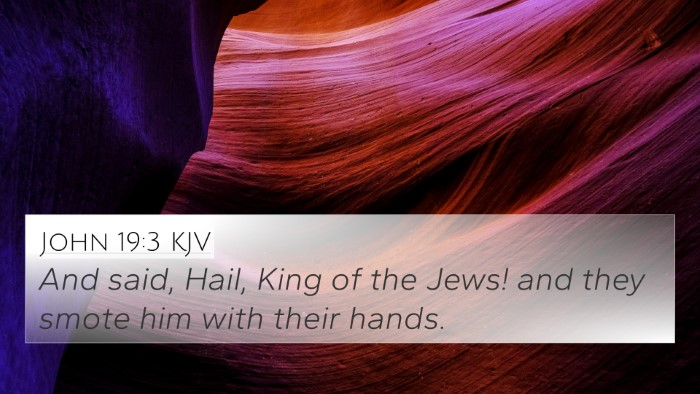Understanding Matthew 26:49
Bible Verse: Matthew 26:49 - "And straightway he came to Jesus, and said, Hail, master; and kissed him."
Summary of Meaning
The verse captures a pivotal moment in the New Testament, where Judas Iscariot betrays Jesus with a kiss, a gesture of affection that conceals his treachery. This act symbolizes the profound irony of betrayal cloaked in familiarity and love.
Insights from Public Domain Commentaries
-
Matthew Henry:
Henry emphasizes the duplicity of Judas's actions, highlighting that the kiss, often a sign of respect, was used as a tool of betrayal. This profound act reminds readers of the nature of false allegiance and the danger of disguising treachery in friendly gestures.
-
Albert Barnes:
Barnes notes the prophetic fulfillment within this event, drawing connections to Old Testament scriptures about betrayal (e.g., Psalm 41:9). He underscores that Judas’s choice to betray Jesus was not just a moment of weakness but reflective of deeper spiritual issues.
-
Adam Clarke:
Clarke elaborates on the cultural significance of a kiss in that era, which was a common greeting among friends. He presents Judas's act as a tragic instance of how intimacy can be corrupted, emphasizing the consequences of sin and betrayal against the backdrop of Jesus’s unfolding passion.
Cross-references and Thematic Connections
Matthew 26:49 is interwoven with several Bible passages that deepen our understanding of its themes:
- Psalm 41:9 - "Even my own familiar friend in whom I trusted, who ate my bread, has lifted up his heel against me." This Psalm foretells betrayal by a close friend.
- John 13:21-27 - Jesus reveals that one of His own disciples will betray Him, highlighting the intimate connection between Jesus and Judas.
- Luke 22:48 - "But Jesus said unto him, Judas, betrayest thou the Son of man with a kiss?" This verse emphasizes the question of loyalty and love versus betrayal.
- Matthew 26:15 - Judas's deal to betray Jesus for thirty pieces of silver underscores the motivations behind betrayal.
- Mark 14:44 - Similar to Matthew, this passage recounts the instructions given by Judas to identify Jesus with a kiss.
- Isaiah 53:3 - This verse speaks of the suffering servant, whose rejection includes betrayal, illustrating the broader context of Jesus's suffering.
- John 18:3 - The role of Judas leading the band of soldiers to arrest Jesus highlights the betrayal’s execution.
- Matthew 5:46-48 - Jesus teaches about loving one's enemies, contrasting with Judas's act of betrayal, urging followers towards genuine love.
- Exodus 21:32 - Mentioning thirty shekels of silver, this also emphasizes the significance of the price of betrayal.
- 1 Corinthians 11:23-26 - The Last Supper serves as a backdrop to betrayal, connecting Jesus’s foreknowledge with the institution of communion.
Comparative Bible Verse Analysis
A comparative analysis of Matthew 26:49 brings to light several important themes and questions:
- Duality of Intention: How can expressions of love be misused for ill purposes? This reflects on human nature.
- Prophecies Fulfilled: Analyzing how Old Testament prophecies relate to New Testament events shows the fulfillment of Scripture.
- Betrayal's Impact: Exploring the impact of betrayal on relationships can lead to discussions about trust and fidelity in the Christian faith.
- The Role of Free Will: Judas’s betrayal raises questions about human agency versus divine foreknowledge.
- Forgiveness and Redemption: Contrasts between betrayal and the path to forgiveness suggested by Jesus’ later actions toward humanity.
Tools for Bible Cross-Referencing
To further explore the connections surrounding Matthew 26:49, various tools can enhance understanding:
- Bible Concordance: Useful for finding related verses by keywords.
- Bible Cross-Reference Guide: Aids in identifying direct relationships between verses.
- Cross-Reference Bible Study Methods: Structured approaches can help analyze themes further.
- Comprehensive Bible Cross-Reference Materials: Leveraging various study aids enhances the depth of study.
Thematic Bible Verse Connections
Consider the themes prevalent in Matthew 26:49 that connect with the broader narrative of Scripture:
- Betrayal: Explored deeply in various contexts throughout the entire Bible.
- Love versus Deceit: How genuine love can be manipulated by sinful intention.
- Prophecy and Fulfillment: The ongoing dialogue between Old Testament prophecies and New Testament realizations.
- Discipleship and Loyalty: The expectations of those closest to Christ versus their actions.
- Consequences of Sin: The personal and communal ramifications of betrayal within the faith community.
Conclusion
Matthew 26:49 serves as a profound reminder of the complexities of trust and betrayal within the narrative of the Gospels. Through careful analysis and cross-referencing with related scriptures, one can uncover deeper insights into the nature of human relationships, the fulfillment of prophecy, and the profound sacrificial love demonstrated by Jesus.













